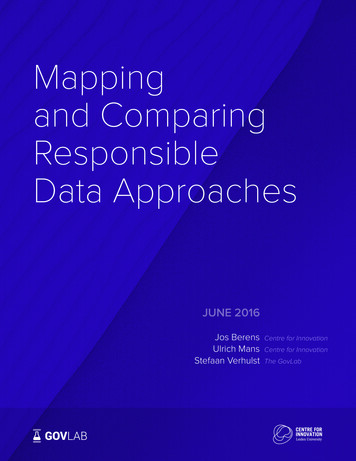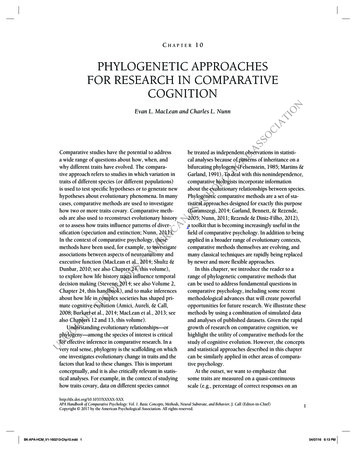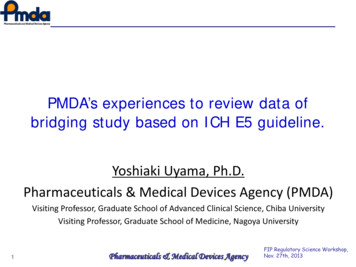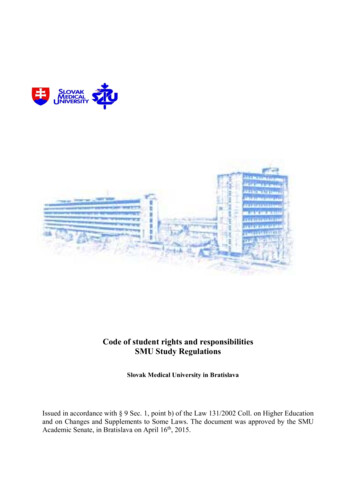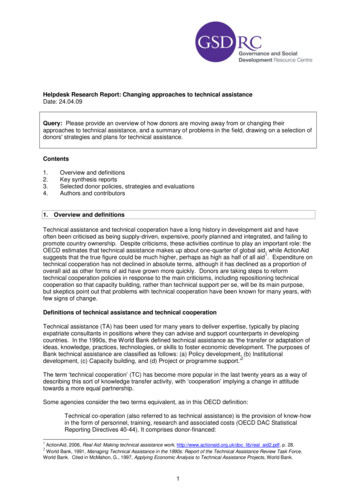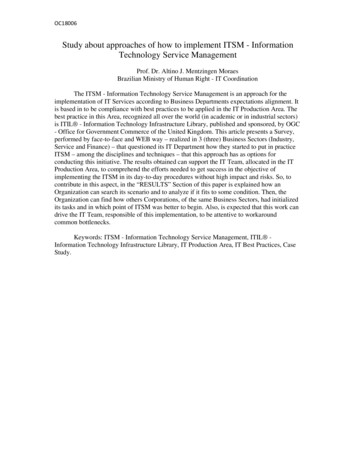
Transcription
OC18006Study about approaches of how to implement ITSM - InformationTechnology Service ManagementProf. Dr. Altino J. Mentzingen MoraesBrazilian Ministry of Human Right - IT CoordinationThe ITSM - Information Technology Service Management is an approach for theimplementation of IT Services according to Business Departments expectations alignment. Itis based in to be compliance with best practices to be applied in the IT Production Area. Thebest practice in this Area, recognized all over the world (in academic or in industrial sectors)is ITIL - Information Technology Infrastructure Library, published and sponsored, by OGC- Office for Government Commerce of the United Kingdom. This article presents a Survey,performed by face-to-face and WEB way – realized in 3 (three) Business Sectors (Industry,Service and Finance) – that questioned its IT Department how they started to put in practiceITSM – among the disciplines and techniques – that this approach has as options forconducting this initiative. The results obtained can support the IT Team, allocated in the ITProduction Area, to comprehend the efforts needed to get success in the objective ofimplementing the ITSM in its day-to-day procedures without high impact and risks. So, tocontribute in this aspect, in the “RESULTS” Section of this paper is explained how anOrganization can search its scenario and to analyze if it fits to some condition. Then, theOrganization can find how others Corporations, of the same Business Sectors, had initializedits tasks and in which point of ITSM was better to begin. Also, is expected that this work candrive the IT Team, responsible of this implementation, to be attentive to workaroundcommon bottlenecks.Keywords: ITSM - Information Technology Service Management, ITIL Information Technology Infrastructure Library, IT Production Area, IT Best Practices, CaseStudy.
INTRODUCTIONIn literature, is possible to find a declaration – in the first page of a book – that saysthat “most people would agree that the IT - Information Technology infrastructure of abusiness is a very critical component that allows that business to operate, to compete and toobtain revenue (Steinberg, 2014, p. 1).Indeed, nowadays is almost impossible to imagine any kind of business that does notneed a strong support of IT to survive in highly competitive world.Thus, this article presents a Survey, performed by face-to-face and WEB way –realized in 3 (three) Business Sectors (Industry, Service and Finance) – that questioned its ITDepartment how they started to put in practice ITSM – among the disciplines and techniques– that this approach has as options for conducting this initiative.The ITSM - Information Technology Service Management is an approach for theimplementation of IT Services according to Business Departments expectations alignment. Itis based in to be compliance with best practices to be applied in the IT Production Area. Thebest practice in this Area, recognized all over the world (in academic or in industrial sectors)is ITIL - Information Technology Infrastructure Library, published and sponsored, by OGC- Office for Government Commerce of the United Kingdom.The results obtained can support the IT Team, allocated in the IT Production Area, tocomprehend the efforts needed to get success in the objective of implementing the ITSM inits day-to-day procedures without high impact and risks.So, to contribute in this aspect, in the “RESULTS” Section of this paper is explainedhow an Organization can search its scenario and how to analyze if it fits to some condition.Then, the Organization can find how other Corporations, of the same Business Sectors, hadinitialized its tasks and in which point of ITSM was better to begin.Also, is expected that this work can drive the IT Team, responsible of thisimplementation, to be attentive to workaround common bottlenecks.Besides that, in the "CONCLUSION" Section, the evaluations presented may help inthe decision-making process on the best way forward, because although this Survey/Researchhas been carried out in Brazil, its results can be applied – with the proper adjustments ofinterpretation – in any Organization in any part of the World.SECTIONSThis paper is partitioned in 6 (six) Sections – and in its Sub-Headers – named asAuthor, Methodology, Theory, Results, Conclusion and Reference.AUTHORThe perception of the existence of different approaches for the implementation of theITSM - Information Technology Service Management, which can interfere in success in theend of this procedure, besides the 45 (forty-five) years of Author expertise in IT Area, wasalso consolidated in academic studies and research articles (the author is Master in IT Information Technology and Ph.D. in Production Engineering, with emphasis in SoftwareHouse).He has 5 (five) IT International Certification (PMI, ABPMP, ITIL , CobiT andISTQB) and, in some prior papers published in National Congresses in Brazil (such as, theENEGEP - National Meeting in Production Engineering, sponsored by ABEPRO - BrazilianAssociation of Production Engineering) and International Conferences abroad (such as, theWMSCI - World Multiconference on Systemics, Cybernetics and Informatics, sponsored byStudy about approaches
IIIS - International Institute of Informatics and Systemics, or the CISTI - Iberian Conferenceon Information Systems and Technologies, sponsored by AISTI - Iberian Association ofSystems and Information Technologies), this subject was already studied.METHODOLOGYLiteratureThis paper was done according to academic models applied to Case Studies. Somesamples of it can be founded in books already printed and offered by the market. An exampleis the book of Hamel, Dufour and Fortin (1993) title as “Case Study Methods”.Also, the book named as “How to Analyze Survey Data” is an additional directive fordriving the capture of information and to build the presentation results (Fink, 1995).These 2 (two) mentioned literatures above (in prior paragraph), and the expertise ofthe Author of this paper, formed the final way as how this task was conducted.ProjectThe Research Project, performed by a Survey carried out in Brazil, followed theActivity Schedule as indicated in Figure 1 (Appendix), following the 4 (four) Phases, namelyas, the 1. Prospecting Phase, the 2. Ranking Phase, the 4. Research Phase and, finally, the 5.Conclusion Phase.In the 1. Prospecting Phase, about 60 (sixty) Companies were contacted, among the 3(three) Business Sectors (Industry, Service and Finance) object of this Study, in order toinvite them to participate in this Survey. Of these 60 (sixty) Companies there was a positiveresponse from 48 (forty-eight) Companies regarding their interest in participating in thisSurvey.In the 2. Ranking Phase, 10 (ten) Companies were selected from the 48 (forty-eight)Companies that responded positively to their interest in participating in this Survey, for each1 (one) of the 3 (three) Business Sectors ((Industry, Service and Finance). These 30 (thirty)Companies, representing the 10 (ten) selected for each 1 (one) of the 3 (three) BusinessSectors (Industry, Service and Finance), were evaluated for having confirmed that they wereusing the techniques of implementation of the ITSM - Information Technology ServiceManagement and also because these were satisfying some criteria with the purpose of makingthe sample more diversified.In the 3. Research Phase, these 30 (thirty) Companies were classified, representing the10 (ten) selected (list of 10 most significant) for each 1 (one) of the 3 (three) Business Sectors(Industry, Service and Finance) by the criteria of "Life Time (years)", "Employees (TotalNumber)" and "IT Annual Budget %". As indicated in Figures 2, 3 and 4 (Appendix) thesedata were organized in Tables, respectively, by the 3 (three) Business Sectors (Industry,Service and Finance).In the 4. Conclusion Phase, it were defined which data would be considered todetermine the results of this Survey, as well as, to define how the Companies interested inusing these results, for to subsidize their decision making of which approach would be betterto follow in their implementation of IT Services, could search its identification based on thecriteria of "Life Time (years)", "Employees (Total Number)" and "IT Annual Budget %".It should be noted that the criteria of "Life Time (years)", "Employees (TotalNumber)" and "IT Annual Budget %" were used to facilitate the identification ofCompanies interested in using these results surveyed with Companies participants in thisSurvey, that is, it were not used criteria such as Company Size defined by the linkStudy about approaches
exto 4154" (for Brazil), by the link "https:/ / /www.usasbe.org/default.aspx" (for the USA) or by the link uri OJ:L:2003:025 : TOC” (for Europe).Following the logic of relating the Companies participating in this Survey to thecriteria of "Life Time (years)", "Employees (Total Number)" and "IT Annual Budget %",were discarded numbers considered "outlier" (marked with underscore and in red color, inFigures 2, 3 and 4, in the Appendix), the average (A) of the remaining values were calculatedand the range of 25% / - 25% (plus twenty-five percent and minus twenty-five percent) wascreated to attribute the Minimum ( ) and the Maximum ( ) values of the sample researched.For the Industry Business Sector, the Minimum ( ) and the Maximum ( ) values for"Life Time (years)" were – respectively – 42 and 70, for “Employees (Total Number)" were –respectively – 140 and 233 and for "IT Annual Budget %" were – respectively – 4.03% and6.71%, as indicated in Figure 2 (Appendix).For the Service Business Sector, the Minimum ( ) and the Maximum ( ) values for"Life Time (years)" were – respectively – 16 and 26, for “Employees (Total Number)" were –respectively – 49 and 82 and for "IT Annual Budget %" were – respectively – 8.89% and14.82%, as indicated in Figure 3 (Appendix).For the Finance Business Sector, the Minimum ( ) and the Maximum ( ) values for"Life Time (years)" were – respectively – 72 and 120, for “Employees (Total Number)" were– respectively – 2.146 and 3.577 and for "IT Annual Budget %" were – respectively –11.34% and 18.90%, as indicated in Figure 4 (Appendix).THEORYIT Service Management (ITSM)“The IT Service Management (ITSM) bridges the world of business with the world oftechnology” (ClydeBank Technology, 2016).This statement, from ClydeBank Technology, in fact defines that the ITSM - ITService Management aims – as its main objective – to provide an IT service with quality andaligned to the needs of the business, seeking long-term cost reduction.Tefertiller (2018), in his book, intends to offer for the IT structure – and itsOrganization leaders – an easy-to-read resource to better understand IT Service Managementand how best to leverage its capabilities.In the book titled as “ITSM Iron Triangle”, written by Mclean (2012), this authorfocuses that as all projects that are people-dependent also the IT Processes implementation(according to ITSM) is no different and it is primordial to obtain the commitment of all staffto facilitate the “break” of no-adequate behaviors and attitudes.This same author also mentioned, in the first chapter of this his book (Chapter 1:Change in Assignment), that ITIL - Information Technology Infrastructure Library – whichwill be explained in the next Sub-Header of this Section – is a way to implement ITSM but hedetails that are necessary many adjusts, in the treatment of each steps, to be well succeed.According to the understandings perceived by the research of these bibliographies itcan be said that IT Service Management (ITSM) is simply the way to manage the delivery ofIT Services, from end-to-end, to the Clients of the IT Information Technology Area based onbest practices. One of the best practices frameworks more adopted for ITSM is ITIL or, asthe acronym indicates, the Information Technology Infrastructure Library.Information Technology Infrastructure Library (ITIL )Study about approaches
The ITIL - Information Technology Infrastructure Library, sponsored, by OGC Office for Government Commerce of the United Kingdom, is composed by 5 (five) Booksand, that is the reason why, it is called as a library. Its 5 (five) Books, with about 400 (fourhundred) pages, in its first version was published in May of 2017 and named as ITIL V3.The second version was released in 2011 and is known as ITIL V3 2011. It became a trademark from this version.The ITIL is a set of best practices, organized in a Service Life Cycle (from theconception of a Service until its discontinuation) for to be implemented in the Infrastructure,in the Operation and in the Management in the IT Area (as is preconized by ITSM). ThisService Life Cycle has a “logical order of implementation” as is defined by ITIL . This“logical order of implementation” is shown as indicated in Figure 5 (Appendix) and thecontents of the Books is described below (in this same “logical order of implementation”).Service Strategy (SS)The book named as Service Strategy (SS) describes how to organize the actions,supported by IT, in Services and the focus is how to create strategies of IT Service Lifecycle.It determines what Services the IT Organization should offer and what capabilities are neededfor to be possible to offer these Services. The aim of Service Strategy is to make theOrganizations think and act in a strategic manner (OGC ITIL Service Strategy, 2011).This task is considered as the initial and as the first step in the “logical order ofimplementation” (and so, this is considered the 1st. Book). This Book is divided in 5 (five)Disciplines as follow: Strategic Management for IT Services (SS/SMS): plans the IT initiatives to supportthe core business activities; Service Portfolio Management (SS/SPM): defines the Services that will beprovided by IT; Demand Management (SS/DM): controls the reception of Demands and track itsresolutions providing prompt “status”, if required; Financial Management for IT Services (SS/FMS): connects the IT actions(Services) with the Budget allocate to execute these; Business Relationship Management (SS/BRM): maintains the alignment betweenthe business goals and the IT targets.Service Design (SD)The book named as Service Design (SD) describes how to design effectively new ITServices. This includes designing new Services and changing and improving the existingones (OGC ITIL Service Design, 2011).This task is considered as the second step in the “logical order of implementation”(and so, this is considered the 2nd. Book). This Book is divided in 7 (seven) Disciplines asfollow: Coordination of Service Design (SD/CSD): coordinates the project of newServices (and its implementation) and also the adaptation of the already inproduction; Service Level Management (SD/SLM): creates SLA - Service Level Agreementsto provide quality Services on time to the End-Users and proactively escalate tolevels of hierarchy to ensure SLA indicators are met; Service Catalog Management (SD/SCaM): showcases the available IT Services toEnd-Users and presents a new “face” to IT. Creates and publishes the ServiceStudy about approaches
Catalog with the SLA - Service Level Agreements customized with multi-stageapprovals;Supplier Management (SD/SM): manages contracts with different Vendors.Tracks IT hardware and software contracts to improve compliance, to associateassets and to receive proactive notifications for contract expirations;Availability and Capacity Management (SD/ACM): plans the needs of ITresources to put in practices new features and releases of equipment andapplications;Service Continuity Management (SD/SCoM): administrates the operation level ofthe Services;Information Security Management (SD/ISM): controls the maintenance of thecriteria of the normative CIA - Confidentiality, Integrity and Availability.Service Transition (ST)The book named as Service Transition (ST) describes how to build and to implementIT Services. It ensures that changes to Services and to Service Management Processes arecarried out in an organized way (OGC ITIL Service Transition, 2011).This task is considered as the third step in the “logical order of implementation” (andso, this is considered the 3rd. Book). This Book is divided in 5 (five) Disciplines as follow: Transition Planning and Support (ST/TPS): focuses in to evaluate and to managethe impacts of install new hardware facilities in the production environment; Change Management (ST/CM): simplifies the planning, the approval and theimplementation of changes by automatized workflows. Eliminates unauthorizedand failed changes; Configuration Management and Service Assets (ST/CMSA): discovers andmaintains the IT Asset Inventory with efficient auto-discovery. Directs the targetto discover IT Assets from Windows, Linux, Mac, AIX, and Solaris, as well asprinters, routers, switches, and more options of OS and hardware; Release and Deployment Management (ST/RDM): completes the ST/TPSDisciplines with the focus in the installation of new applications version in theproduction environment; Knowledge Management (ST/KM): empowers the End-Users to solve recurrentincidents by Knowledge Base research to allocate rightly the Tickets to IT HelpDesk. Limits the search using keywords and topics.Service Operation (SO)The book named as Service Operation (SO) describes how to delivery effective andefficient IT Services. It includes fulfilling Customer requests, resolving Servicedisappointments in the deliveries, fixing problems, and carrying out routine operationalprocedure (OGC ITIL Service Operation, 2011).This task is considered as the fourth step in the “logical order of implementation” (andso, this is considered the 4th. Book). This Book is divided in 5 (five) Disciplines as follow: Event Management (SO/EM): receipts the automated warnings from eventualincidents detected and directs for the evaluation of the Checking Group; Incident Management (SO/IM): reduces outages, improves productivity, meetsSLA - Service Level Agreements and manages the complete Life Cycle of ITTickets. Automates Ticket workflows to let IT Technicians focus on otherimportant tasks;Study about approaches
Request Compliance (SO/RC): maintains the IT Environment under compliancewith legal determinations and technical rules, including, the Development and theInfrastructure Areas;Problem Management (SO/PM): classifies, analyzes, and closes problems.Analyzes root causes and reduces recurrent incidents to boost the IT Help-Desk'sproductivity;Access Management (SO/AM): manages the active End-Users list and controls itsauthentication in the Production Environment.Continual Service Improvement (CSI)The book named as Continual Service Improvement (CSI) describes how to improvecontinually the quality of IT Services in line with the concept of Continual ServiceImprovement adopted in ISO 20000 (OGC ITIL Continual Service Improvement, 2011).This task is considered as the final and as the fifth step in the “logical order ofimplementation” (and so, this is considered the 5th. Book), although, this one can be startedat any time (that is the reason why it is highlighted with an Interrogation Mark when ispresented in the Flow of Implementation of the ITSM - IT Service Management in all Figuresof this paper). This Book is divided in 3 (three) Disciplines as follow: Identify Opportunities for Improvement (CSI/IOI): processes the problemsoccurred, to understand them and for proposing new solutions that has the targetto solve forever the issue; Prioritize the Identified Improvements (CSI/PII): organizes the projects toimplement the improvements in the IT Environment. Implement Improvement Initiatives (CSI/III): puts in practice the results obtainedwith the projects constructed for implementing the improvements.RESULTSIn the sequence of the Research Phase of this Case Study, described in the "Project"Sub-Header of the “METHODOLOGY” Section, the Companies participating in this Surveywere asked about the order of implementation of the Disciplines of ITIL - InformationTechnology Infrastructure Library in the implementation of the theory of ITSM - InformationTechnology Service Management.This information, about the order of implementation of the Disciplines of ITIL Information Technology Infrastructure Library, was registered by the effort - in percentage applied by the Companies participating in this Survey in the implementation of eachDiscipline, which, also shows the degree of importance considered for the Discipline as thepriority of its implementation.The expected percentage of efforts (costs and time) for the implementation of thetheory of ITSM - Information Technology Service Management, researched in the literatureand experimented by the Author’s expertise, is indicated in Figure 6 (Appendix) in theLogical Order of Implementation (Theory). Since Continual Service Improvement (CSI) canonly be applied, at first time when at least one Cycle of Implementation is finished, thepercentual for this task does not have a preview defined percentage. Thus, for the ServiceStrategy (SS) is 40% (forty percent), for the Service Design (SD) is 25% (twenty fivepercent), for the Service Transition (ST) is 20% (twenty percent) and for the ServiceOperation (SO) is 15 (fifteen percent).The presentation of these data is as indicated in Figure 6 (Appendix), in which, it ispossible to be visualized a Data Table that shows this information in one more interpretableStudy about approaches
way, considering a scale of 5% (five percent) percentages, what means to say that, valueshave been rounded up or down.Thus, fractional intermediate values equal to or less than 2.50 (two and a half) and7.50 (seven and a half) were converted to the previous smaller value multiple of 5 (five) andfractional intermediate values greater than 2.50 (two and a half) and 7.50 (seven and a half)were converted to the posterior bigger value multiple of 5 (five).The remainders of the division, of these rounding, were accounted for in other valuesto make them more meaningful and can better present the degree of effort applied in theimplementation of the Disciplines of ITIL - Information Technology Infrastructure Library,and with it, to be easier to interpret which Flow of Implementation has been followed (byeach Business Sector) and to facilitate the choice of which path to follow by Companies thatare interested in researching the results of this article.In this Data Table (in each line of the Disciplines of ITIL and in each BusinessSector), the higher value (percentage) and the lower value (percentage) were marked in redcolor and marked in green color, respectively. It was done for to be possible to find easily theextremes percentages found.Also, as indicated in Figure 6 (Appendix), it is possible to be visualized a Data Graph,based on the rightmost 3 (three) Columns (with the letter "A" that the meaning is "Average")in the Data Table. This average was not adjusted, that is, it was not rounded to multiples of5% (five percent), and therefore, it is the average of the calculated percentages that were thebasis for the construction of the Data Table. The objective is to present more accurately theresults obtained and to better to subsidize the assembly of the Flow of Implementationfollowed (by each Business Sector) in a more real way.In this same Data Graph is possible to view (in the footer subtitle) the average totalpercentage for each ITIL Book Processes. This total does not correspond to a scale of 100%(one hundred percent) since in the Data Table, as already mentioned before, the percentageswere rounded for adequation to multiples of 5% (five percent) for better and easierinterpretation.CONCLUSIONThis Section will describe some conclusions that could also support the Companies,besides the points already explained and mentioned in “INTRODUCTION” Section,“METHODOLOGY” Section (“Project” Sub-Header) and “RESULTS” Section, to identifythemselves with the reality found and to choose/to decide the best way to go according to itsproject about the implementation (or the revision of the current flow) of the ITSM - ITService Management.The Companies, that are interested in to research the results of this paper to support itsdecision of how implement its ITSM - IT Service Management, can find the 3 (three) Flowsof Implementation, representing the 3 (three) Business Sectors (Industry, Service andFinance), build in the end of this survey, as is indicated in the Figures 7, 8 e 9 (Appendix).These same 3 (three) Data Graphics of the 3 (three) Flows of Implementation werealso based on the rightmost 3 (three) Columns (with the letter "A" that means "Average") inthe Data Table.Confirming the information already provided in “RESULTS” Section about the DataGraph of the Figure 6 (Appendix), these averages also were not adjusted (that is, these werenot rounded to multiples of 5% [five percent], and therefore, these are the averages of thecalculated percentages that were the basis for the construction of the Data Table) and theobjective is the same, what it means, to present more accurately the results obtained and toStudy about approaches
better to subsidize the assembly of the Flow of Implementation followed (by each BusinessSector) in a more real way.Regarding these 3 (three) Flows of Implementation of the ITSM - IT ServiceManagement, constructed based in the facts detected in the real world, some conclusions –described below for each one of the 3 (three) Business Sectors (Industry, Service andFinance) – can be retrieved and can also helping to understand how some occurrences havehappened.It is possible to understand that even in the Business Sector of Industry and in theBusiness Sector of Finance, that are known for having Types of Organization that invests inplanning and that are extremely regulated by formal internal and external rules andprocedures, the Disciplines of the Service Strategy (SS) Process were not deeplyimplemented, even with this Service Strategy (SS) Process being considered the initial andthe first Process of ITIL to be implemented by the logic of the Flow of Implementation ofthe ITSM - IT Service Management.Some efforts of Industry Sector and the Finance Sector in the implementation ofDisciplines of Service Strategy (SS) Process were concentrated in the Disciplines of BusinessRelationship Management (SS/BRM), a little bit more in Industry Sector (according its moreidentity with this theme) and in the Financial Management for IT Services (SS/FMS), a littlebit more in Finance Sector (according its more identity with this theme).Minimum percentage efforts in the implementation of other Disciplines of the ServiceStrategy (SS) Process, such as the Discipline of Service Portfolio Management (SS/SPM),were informed by Industrial Sector and the Finance Sector and these were considered asinsignificants. So, these were registered as “zero”.Both the Industrial Sector and the Finance Sector reported that there were problemslatter occurred by the reason of them not had attributed the special attention that thisDiscipline of Service Portfolio Management (SS/SPM), of Service Strategy (SS) Process,should deserve.Regarding still the same Service Strategy (SS) Process, and its Disciplines, it is a factthat in the Service Sector (since the other Disciplines were considered as “zero”) only theDiscipline of Service Portfolio Management (SS/SPM) had some investment in effort when itwas implemented (comparing with the Industrial Sector and with the Finance Sector), since itis just impossible to run the ITSM - IT Service Management directives without, at least, withthis Discipline implemented.All the 3 (three) Business Sectors (Industry, Service and Finance) invested deeply(with big percentage of efforts) to implement the Disciplines of the Service Operation (SO)Process bypassing the previous implementation of the Disciplines of the Service Design (SD)Process, the Disciplines of the Service Strategy (SS) Process and the Disciplines of theService Transition (ST) Process, those that come first according to ITIL Flow.Only some efforts were allocated in the Disciplines of the Service Level Management(SD/SLM), of the Service Catalog Management (SD/SCaM) and of the Supplier Management(SD/SM), components of the Service Design (SD) Process, since it is also just impossible toimplement any ITIL Process without the minimum of these 3 (three) Disciplinesimplemented before.Although not being so important for Industry Sector and for the Service Sector (thepercentage of its efforts were registered as “zero” in the Data Table), for the Finance Sectorthe Discipline of Information Security Management (SD/ISM) – of the Service Design (SD)Process – had a significant aggregated value and has received a good percentage.Comparatively to Industry Sector and to Finance Sector, Service Sector invested a bigpart of its efforts (and time and costs) in the implementation of the Discipline of ChangeManagement (ST/CM) of the Service Transition (ST) Process. It can be explained since it is aStudy about approaches
Business Sector that is always been impacted by changes in the market, besides, living inconstant market concurrence. So, as would be normal and was expected, Service Sector needsto be able in to adapt its IT Operation very fast to maintain your level of competitiveness andcompliance with market standards.Another important point, that must be highlighted, is that the Discipline of KnowledgeManagement (ST/KM) that is related to Service Transition (ST) Process and is the foundationto create a Knowledge Data Base to save and to retrieve workaround solutions (alreadyapplied with success to solve issues and keep the IT environment in normal operation, what isone of the most important targets of ITIL ), had no significant
Department how they started to put in practice ITSM - among the disciplines and techniques - that this approach has as options for conducting this initiative. The ITSM - Information Technology Service Management is an approach for the implementation of IT Services according to Business Departments expectations alignment. It

